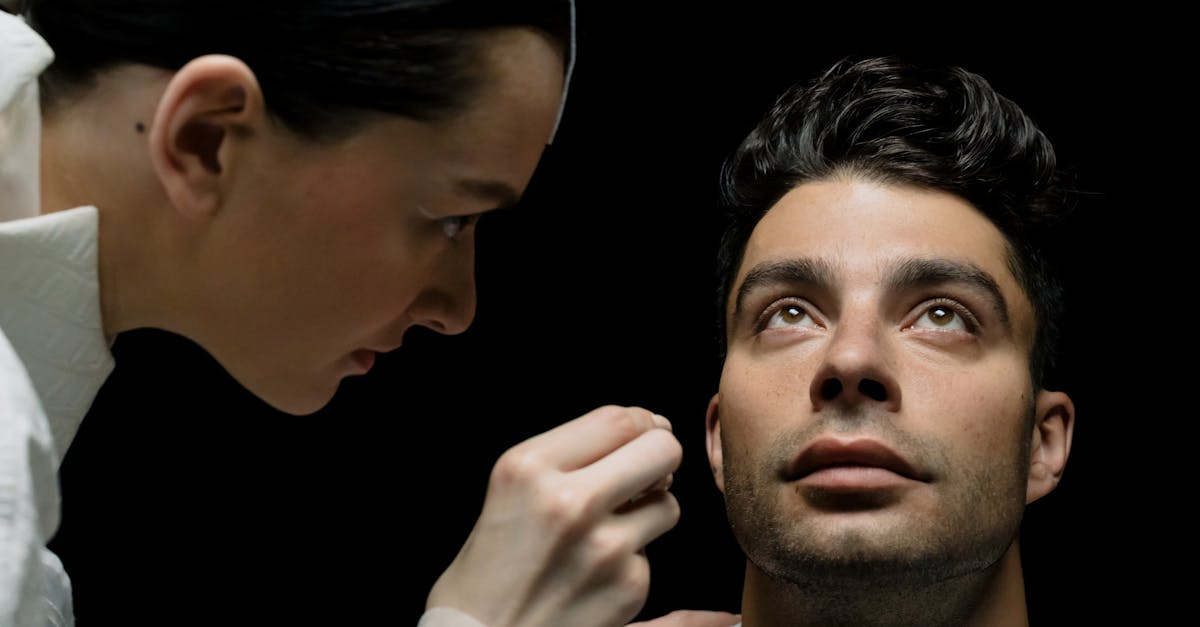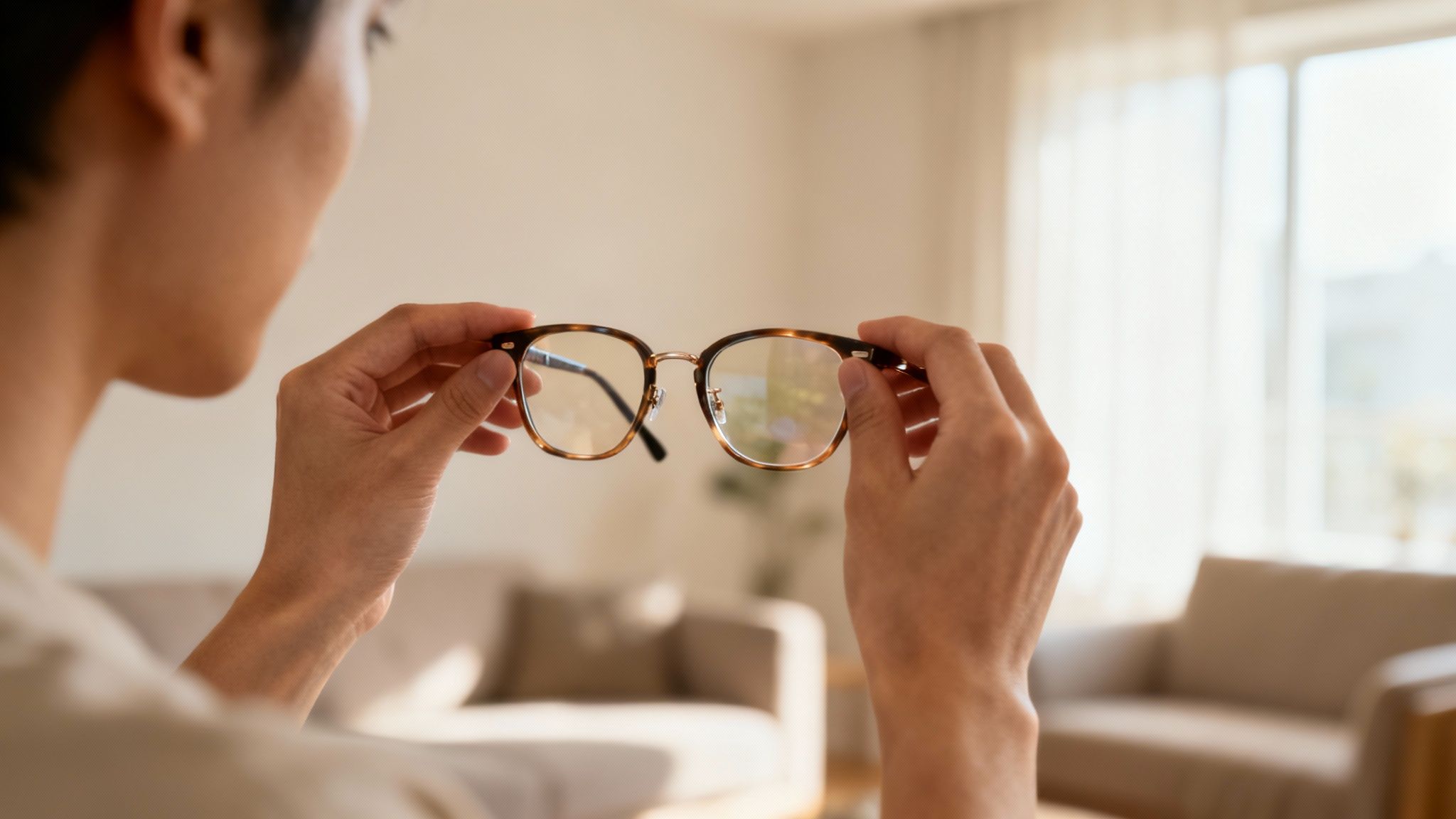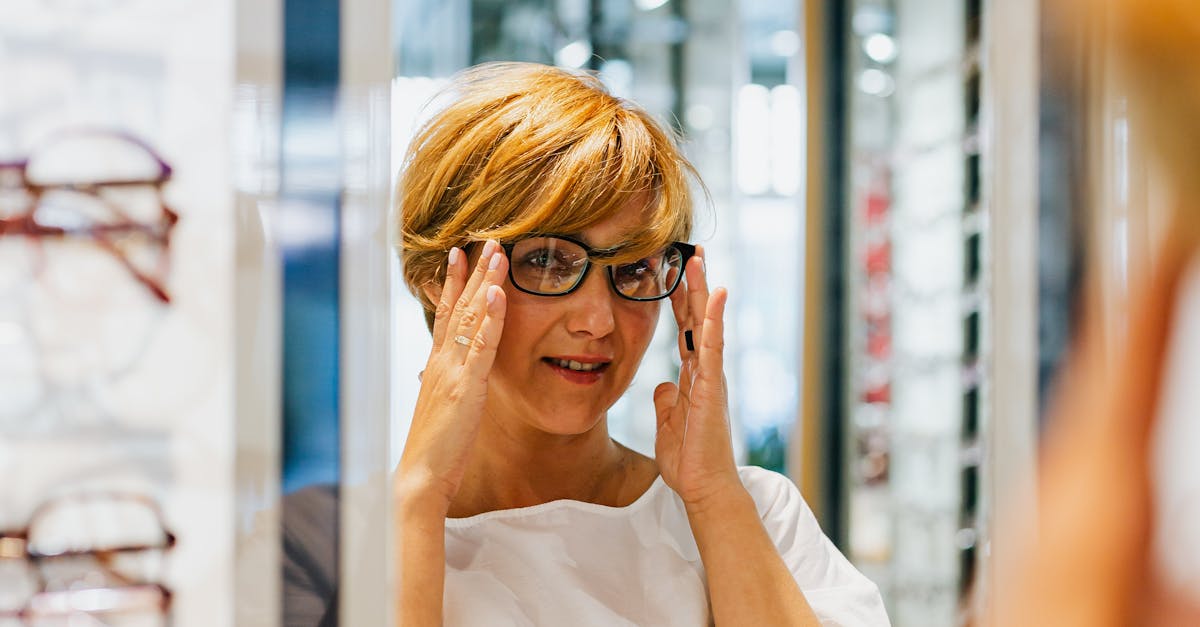If you’ve ever wrapped up a long day of computer work—or even just an afternoon of scrolling on your phone after a walk through Camera Park—you know the feeling. That gritty, tired, blurry-eyed sensation is all too common for residents in Glendale Heights and the surrounding Chicagoland suburbs.
Fortunately, preventing computer eye strain isn't complicated. It really comes down to a few core habits: taking smart breaks, setting up your workspace correctly, and making sure your eyes have the right support. These small changes can make a world of difference in your day-to-day comfort. At iDoctor, your local optometry boutique, we’re here to guide you through it.
What Is Digital Eye Strain?
For many of us here in Glendale Heights, the headaches, sore neck, and general eye fatigue after hours on a screen are a daily reality. This cluster of symptoms has a name: digital eye strain, also known as computer vision syndrome (CVS). It happens because our eyes have to work much harder to read off a digital screen than they do to read off a printed page.
Think about it this way: the letters in a book are solid and sharply defined. On a screen, characters are made of tiny pixels, which have fuzzier edges and less contrast against the background. This forces your eyes into a constant state of refocusing, which fatigues the eye muscles over time.
On top of that, we tend to blink about half as often when we’re locked onto a screen, leading to that all-too-familiar feeling of dryness and irritation.
Why Screen Time Is So Taxing
This isn't a niche problem—it's incredibly widespread. A 2023 analysis revealed that around 66% of digital device users report symptoms of computer vision syndrome. The issue really took off as more people, from professionals in Glendale Heights to students at our local schools, made the switch to remote work and online learning. You can learn more about these findings on digital eye strain in the full study.
Several things work together to create this discomfort:
- Poor Lighting: Glare from a window or harsh overhead lights forces you to squint and strain.
- Improper Viewing Distance: Having your screen too close or too far away makes your eyes constantly struggle to focus.
- Incorrect Posture: Hunching over your desk doesn't just hurt your back; it strains your neck and shoulder muscles, which is often tied to eye discomfort.
- Uncorrected Vision Problems: Even a very slight vision issue that you might not otherwise notice can be significantly amplified by screen use.
The good news? Digital eye strain doesn’t typically cause permanent vision damage. But its symptoms can absolutely wreck your productivity and just make you feel miserable. The key to relief lies in making small, conscious adjustments throughout your day. For a deeper dive, check out our guide on understanding computer vision syndrome.
As your local eye doctor right here on North Avenue, we see how this affects our community every single day. The first step toward feeling better is simply recognizing the symptoms and understanding what’s causing them.
Designing Your Eye-Friendly Workspace
Creating a workspace that’s easy on the eyes is one of the most powerful things you can do to fight computer eye strain, and you can start right now. It doesn't matter if your office is a dedicated room or just a corner of your kitchen table in Glendale Heights; a few smart adjustments will make a huge difference in how your eyes feel after a long day.
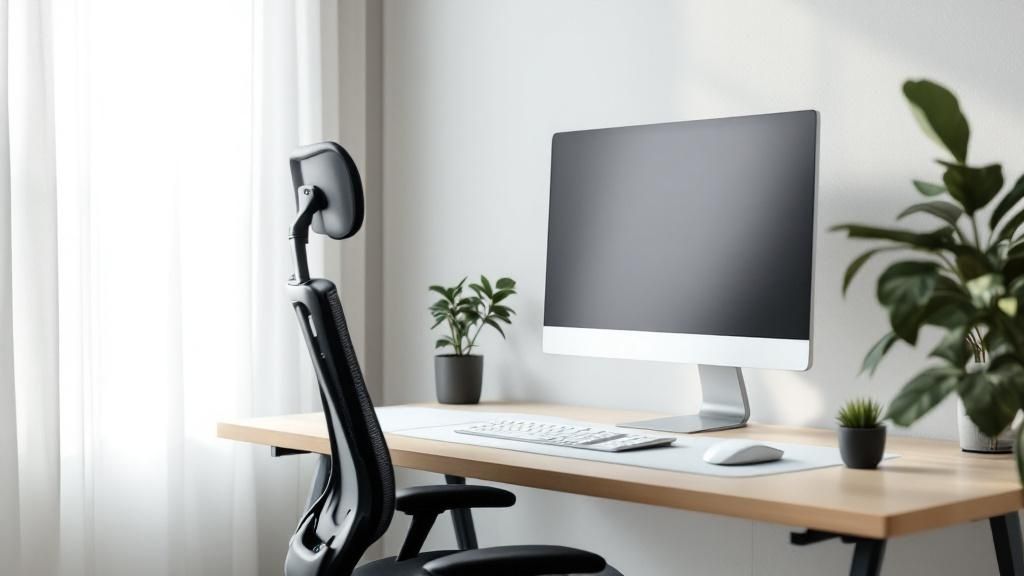
It really all starts with where your monitor sits. So many of us place our screens too high or too close, which forces our eyes and neck into awkward, strained positions for hours on end. The goal is simple: create a setup that feels completely natural to look at.
These small, preventative ergonomic steps—like tweaking screen brightness and managing your lighting to cut down on glare—are proven to have a big impact. In fact, studies show these minor changes, when paired with good habits, are highly recommended for reducing the risks of digital eye strain. You can learn more about the findings on ergonomic interventions from recent research.
Perfect Your Monitor Placement
Let's find the sweet spot for your screen. A great place to start is with the arm's length rule. Sit back in your chair as you normally would and stretch your arm straight out. Your fingertips should just about graze the surface of your screen. That distance, which is usually between 20 to 28 inches, is perfect for comfortable focusing.
Next up is height. The very top edge of your monitor should be at, or just a hair below, your natural eye level. This positioning encourages a slight downward gaze, which is a more relaxed posture for your eyes. It also helps reduce the exposed surface of your eyeballs, which can cut down on dryness.
Key Takeaway: Think of your screen placement as the foundation of a comfortable workspace. When you get the distance and height just right, you stop your eye muscles from constantly overworking—a major cause of headaches and fatigue.
Tame Glare and Master Lighting
Glare is the arch-nemesis of comfortable vision. It’s that annoying reflection from a window or an overhead light that makes you squint and strain. The easiest way to beat it is to position your desk so that any windows are to your side, rather than directly in front of or behind you.
But if you can’t move your desk, don't worry. You've still got options:
- Try a Matte Screen Filter: These are inexpensive films that stick right onto your monitor. They do a fantastic job of diffusing reflections, giving you a softer, easier-to-read display.
- Balance Your Room Lighting: Working in a pitch-dark room with a super-bright screen is a recipe for eye strain. That stark contrast is just too harsh. Instead, try to match your screen's brightness to the overall ambient light in your room.
- Use Task Lighting: If you're looking at papers or notes, a small desk lamp aimed at your documents is a great idea. It stops you from turning your monitor brightness way up just to see what you're writing.
Optimize Your Desk Accessories
Finally, let's think about the other items on your desk. If you’re constantly looking back and forth between your screen and papers lying flat on your desk, you're making your eyes refocus and your neck work overtime with every glance.
A simple document holder placed right next to your monitor can be a game-changer. By keeping your reference materials at roughly the same height and distance as your screen, you dramatically reduce the work your eyes and neck have to do. It’s these small, thoughtful tweaks that really add up to a more comfortable and productive day.
Better Screen Habits and Simple Eye Exercises
Getting your workstation set up correctly is the first big win, but the habits you build day-to-day are what really save your eyes in the long run. Think of it this way: having a top-of-the-line kitchen doesn't make you a great chef. You still need the right techniques.
When it comes to eye health, the most famous technique is the 20-20-20 rule. Its brilliance is in its simplicity.
Here’s all you have to do: every 20 minutes, find something 20 feet away and look at it for at least 20 seconds. That’s it. This tiny action forces the small ciliary muscles inside your eyes to relax, giving them a much-needed break from staring at a close-up screen. It's a quick reset that prevents eye fatigue from compounding throughout the day.
This is a game-changer, whether you're a student at Glenbard West High School prepping for exams or a local professional stuck in endless Zoom meetings. It’s a micro-break you can fit into even the most packed schedule.
Go Beyond the 20-20-20 Rule
The 20-20-20 rule is a fantastic starting point, but you can add a couple more simple exercises to your routine to give your eyes even more relief. You can do these right from your desk, no equipment needed.
- Palming: Rub your hands together to generate a little warmth. Then, gently close your eyes and cup your warm palms over them without putting any pressure on your eyelids. The combination of gentle warmth and total darkness is incredibly soothing for tired eye muscles. Hold this for about 30 to 60 seconds.
- Focus Shifting: This one helps your eyes stay flexible. Hold a finger a few inches away from your face and focus on it for a moment. Then, shift your gaze to something far across the room. Go back and forth between near and far about 10 times.
These exercises aren't just quick fixes; they're about building sustainable habits that protect your vision for years to come. If you're looking for more, check out our guide on eye exercises for eye strain for other simple techniques you can weave into your workday.
This visual guide shows a simple, three-part approach to setting up your screen and lighting to minimize visual stress.
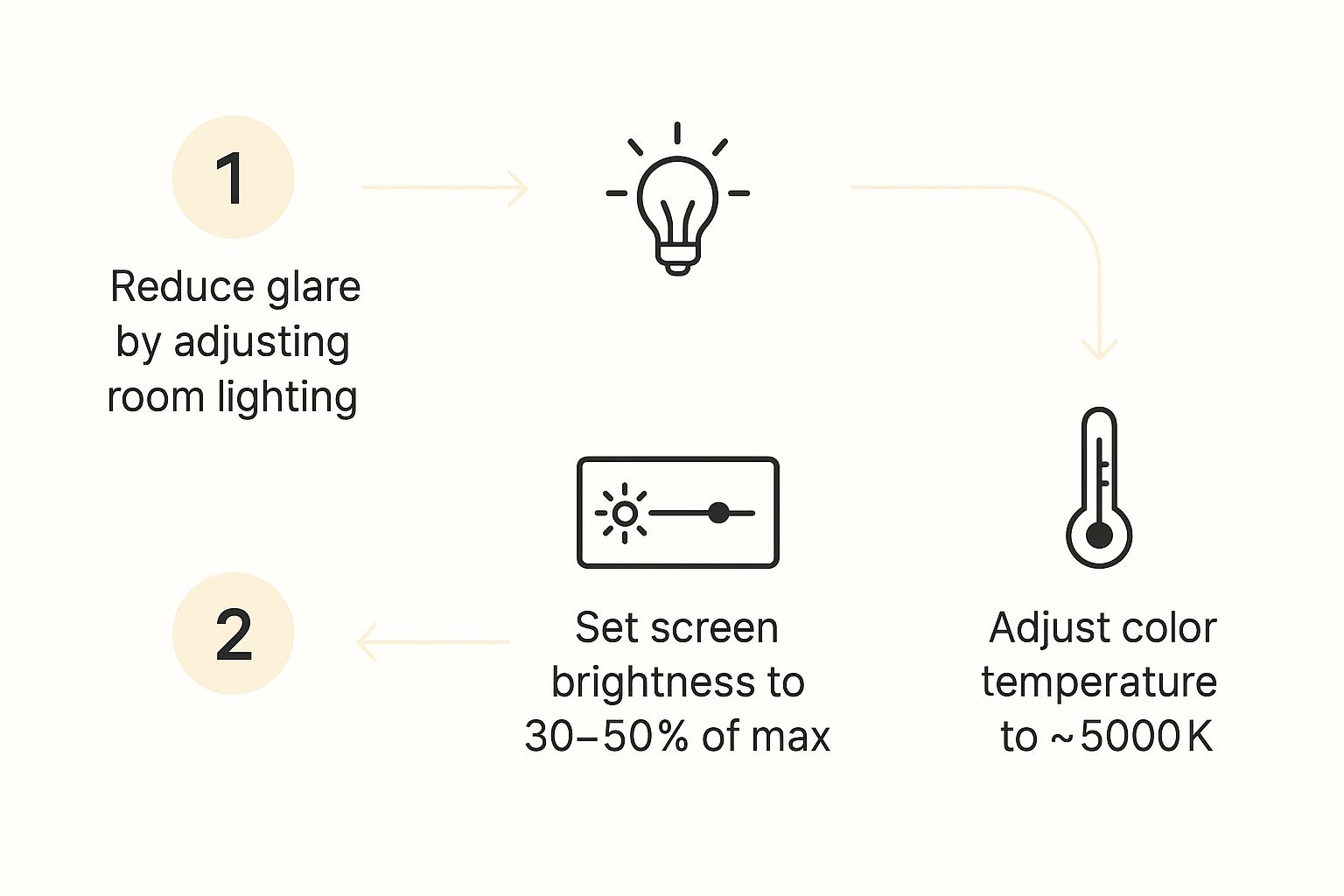
As you can see, creating an eye-friendly setup is all about finding the right balance between the light in your room and the settings on your screen to cut down on harsh contrasts and glare.
Don't Forget to Blink!
It sounds almost ridiculously simple, but it’s a huge deal. When we’re staring at a screen, we tend to blink about 50% less than we normally would. This is one of the main reasons our eyes feel dry, gritty, and just plain irritated after a long day.
Blinking is your body’s built-in mechanism for cleaning and moisturizing the surface of your eyes.
A simple sticky note on the corner of your monitor that just says "Blink!" can make a world of difference. Making a conscious effort to blink fully and often is one of the single most effective things you can do to combat the dryness that comes from screen time.
Tweaking Your Lighting and Screen for Maximum Comfort
It's not just about your posture or taking breaks. The light around you and the light coming from your screen are huge factors when it comes to eye comfort. If you can create a balanced visual environment, you're already halfway to beating computer eye strain. The goal here is simple: get rid of harsh contrasts and annoying glare that make your eyes work way harder than they need to.
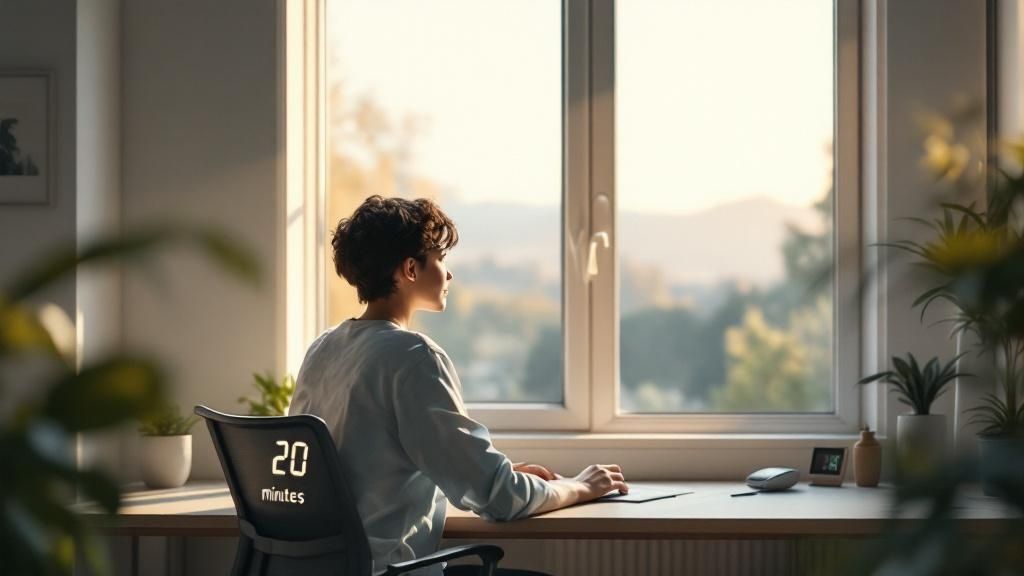
Think of it as a balancing act. The ambient light in your room and the light from your monitor need to be in sync. A super bright screen in a pitch-dark room? That's a recipe for fatigue and headaches. The reverse is just as bad—a dim screen in a sunny room will have you squinting and straining.
You want them to match. Your screen’s brightness should blend into the room, not feel like a spotlight pointed directly at your face.
Get Your Room's Lighting Right
First things first, let's get a handle on the light sources around your workspace. The most common offender causing eye strain is glare, which is just light bouncing off your screen and into your eyes.
- Position Your Desk Smartly: This is a big one. If you can, set up your desk so that any windows are to your side, not directly in front of or behind your screen. It's a simple move that can cut down on glare immediately.
- Soften Your Light Sources: Harsh, direct overhead lights can be just as problematic as a bright window. Try using floor or desk lamps for softer, indirect lighting that's much gentler on the eyes.
- Tame the Windows: If moving your desk isn't an option, use curtains or blinds. This gives you direct control over the sunlight, allowing you to adjust the room's brightness as the day goes on.
For anyone who finds reflections especially distracting, it’s worth looking into the benefits of anti-glare glasses. They can make a world of difference.
Dial in Your Display Settings
Your computer, tablet, and phone all have settings designed to make the screen easier to look at. Spend a few minutes playing around with them; you might be surprised at the instant relief you feel.
The most important thing to remember is that your screen should work for you. Don't settle for the default factory settings. A few simple tweaks to match your environment can be one of the most powerful ways to fight digital eye strain.
Here are a few key adjustments I always recommend:
- Turn on the Blue Light Filter: Almost every modern device has a "Night Shift," "Night Light," or "blue light filter" mode. It warms up the screen's colors, cutting down on that harsh blue light often blamed for eye fatigue and even messing with your sleep.
- Make the Text Bigger: Find yourself leaning toward the screen to read? The text is too small. Head into your display settings and bump up the default font size. This simple change will stop you from squinting all day long.
- Adjust the Contrast: Upping the contrast can make text pop against the background. This makes it sharper and easier to read, meaning your eyes don't have to put in as much effort to focus.
When to Consider Professional Eye Care and Glasses
You’ve tweaked your workspace, you’re taking breaks, and you’ve fiddled with every screen setting imaginable. But the headaches, blurry vision, and tired eyes are still a daily struggle. If you've tried everything and the discomfort just won't go away, that’s a pretty clear sign that at-home fixes aren't cutting it. It's time to bring in a professional.
Sometimes, even a very slight vision problem that you wouldn't normally notice can become a huge source of strain when you’re staring at a screen for hours. A comprehensive exam with an eye doctor in Glendale Heights is the only way to catch and correct these subtle issues before they become a major problem.
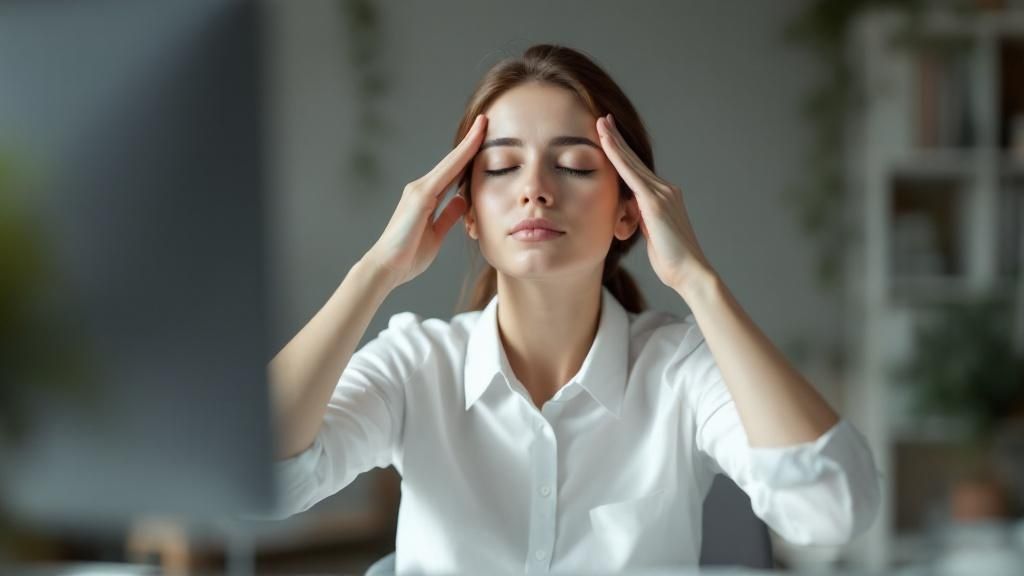
This is where our 30-minute detailed eye exams in Glendale Heights can truly make a world of difference. Using high-resolution imaging, we get an incredibly precise picture of your eye health.
The Power of Computer Glasses
One of the most effective tools in our arsenal against digital eye strain is a pair of specialized computer glasses. These aren't your average drugstore readers; they're custom-designed to tackle the specific demands of screen work.
So, what makes them so special? It comes down to two key things:
- Optimized Focal Distance: Think about where your computer screen sits. It's in that weird "in-between" zone—further than a book but closer than you'd need for driving. Computer glasses are prescribed specifically for this intermediate distance, typically 20-28 inches, which allows your eye muscles to finally relax.
- Advanced Lens Coatings: This is where the magic happens. An anti-reflective (AR) coating is crucial for cutting down glare from office lights or windows. On top of that, a blue light filter can help ease the visual fatigue that many people experience after a long day in front of a screen.
The right pair of computer glasses can completely change your workday. By giving your eyes the right tool for the job, you’re drastically reducing their workload. The result? Fewer headaches, less dryness, and better focus from morning to night.
Finding the Perfect Fit and Style
Here at iDoctor, we firmly believe you should never have to choose between clear vision and great style. The good news is, these high-tech coatings can be added to almost any lens.
This means you can get the relief you need without sacrificing your look. Whether you’re searching for the classic elegance of Cartier glasses near me or prefer the contemporary designs of Tom Ford and Gucci, we can outfit them with lenses perfectly tuned for your digital life.
We also carry a fantastic selection of stylish and more accessible brands like Ray-Ban, Kate Spade, and Coach, so there’s truly something for every personality and budget. Our team is here to help you find frames you’ll be excited to wear and lenses that deliver real, noticeable comfort.
The First Step Toward Relief
If your eyes are constantly feeling strained, they're trying to tell you something. A thorough eye exam is the most important first step. It lets us rule out any other underlying problems, dial in the exact prescription you need for your screen distance, and recommend the lens technology that will work best for you.
With so much of our lives spent on screens, regular check-ups are more important than ever. If you're curious about the ideal schedule, our guide on how often you should get an eye exam has all the details. Don’t let eye discomfort slow you down when a solution is right here in Glendale Heights.
Build Habits That Support Lasting Eye Health
Everything we've talked about so far—ergonomics, screen settings, and exercises—is incredibly effective. But to truly win the battle against computer eye strain, you need to think beyond your desk. It’s the small, consistent habits you build into your everyday life that create a strong foundation for healthy vision.
Think about it this way: if you’re dehydrated, one of the first things your body does is conserve water. This can quickly lead to dry, gritty, and irritated eyes, which only makes digital eye strain feel worse. Simply keeping a water bottle nearby and sipping throughout the day is a small change with a big impact.
Feed Your Eyes the Right Fuel
It's no surprise that what you eat directly affects your vision. Loading your diet with specific nutrients can protect your eyes from daily stressors and help them function optimally.
Try to work more of these into your meals:
- Omega-3 Fatty Acids: Think fatty fish like salmon and tuna. These are fantastic for maintaining moisture and tamping down inflammation.
- Lutein and Zeaxanthin: These are powerful antioxidants found in leafy greens like spinach and kale that act like an internal filter for harmful blue light.
- Vitamins C and E: Citrus fruits, berries, and nuts are packed with these vitamins, which support your overall ocular health.
For more great ideas on what to add to your grocery list, check out our guide on the best foods for eye health.
Don't underestimate the power of a good night's sleep. Quality rest is when your eye muscles finally get a chance to fully relax, repair, and recover from the day's work. It makes a world of difference.
The Hidden Strain of Multitasking
We all do it—checking our phone while watching a movie or answering emails on a laptop during a video call. This constant device-juggling feels productive, but it’s a huge source of strain for our eyes.
A landmark survey revealed something telling: while 65% of adults reported symptoms of digital eye strain, that number shot up to 75% among people who regularly used two or more devices at the same time. You can read the full study on device multitasking and eye strain to dig into the data yourself.
When you focus on one screen at a time, you give your eyes a single, stable focal point. They aren't constantly shifting and struggling to refocus. Making a conscious effort to single-task can dramatically cut down on the fatigue you feel at the end of the day.
Answering Your Questions About Computer Eye Strain
We get a lot of great questions about digital eye strain here at our Glendale Heights practice. Let's tackle a few of the most common ones we hear from our community.
Where can I find the best optometrist in Glendale Heights for eye strain?
At iDoctor, we specialize in diagnosing and treating digital eye strain. Our detailed 30-minute eye exams use high-resolution imaging to get a precise look at your eye health. This allows us to create personalized solutions, from custom computer glasses to lifestyle recommendations, to bring you relief. We're conveniently located on North Avenue, ready to serve our Glendale Heights neighbors.
Can I get blue light filtering on a pair of designer frames?
Absolutely! You don't have to choose between protecting your eyes and loving your look. We can add advanced anti-reflective and blue light filtering coatings to almost any frame we carry. This includes our entire curated collection of designer eyeglasses in Glendale Heights, featuring incredible styles from luxury brands like Cartier, Gucci, Prada, and Tom Ford.
I'm on a computer all day. How often should I get my eyes checked?
If your job involves staring at a screen for hours on end, we can't stress this enough: get a comprehensive eye exam every single year. It's about more than just checking your prescription. These annual visits allow your optometrist to spot the subtle, early signs of digital strain and ensure your vision is perfectly tuned for the unique demands of screen work. Consistent check-ups are truly the best way to protect your long-term eye health in Glendale Heights.
Do you accept vision insurance for eye exams and glasses?
Yes, we do! iDoctor accepts all major vision insurance plans to make exceptional eye care as accessible as possible for the Glendale Heights community. Our team can help you understand and maximize your benefits for everything from your annual eye exam to a new pair of stylish eyeglasses or contact lenses.
Ready to give your eyes the relief they've been asking for? The team at iDoctor is here to help you find the perfect solution, whether it's an advanced lens coating or a stylish new pair of frames. From the moment you walk through our doors in Glendale Heights, you'll receive the warm, professional care you deserve. Schedule your personalized eye exam today and see what a difference professional care can make.


